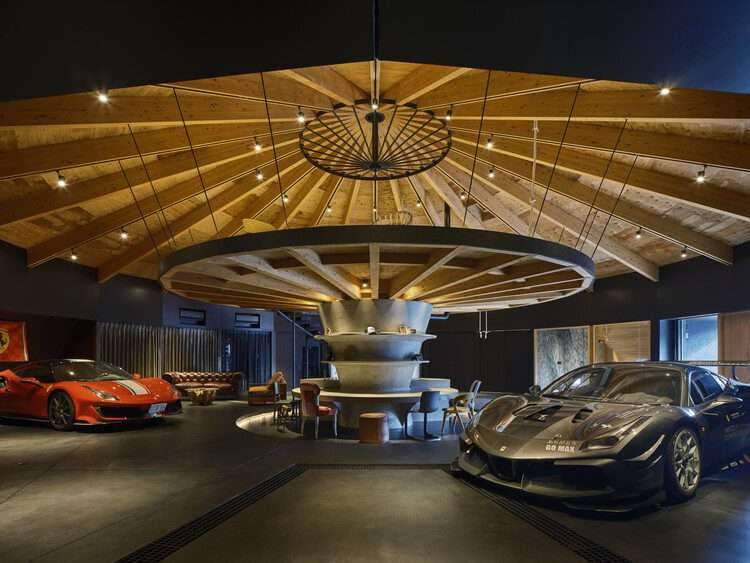andrea zittel created five bench sculptures in soft red to gather people at esters garden house
andrea zittel created five bench sculptures in soft red
Artist Andrea Zittel created five bench sculptures in soft red tones for Esters Garden House to complete her permanent exhibition design and public art in the garden house, doubling as a means to gather people visiting Kunstmuseen Krefeld Museum in Krefeld, Germany. The artistic practice of Zittel touches upon the strategies, means, and forms of design and architecture while infusing the nuances of geometry by the way her works enjoy lines, edges, and shapes. For the most part, her artworks and sculptures act as interventions in life based on her reduced, modular worldview, and the artist uses her body of work to examine the legacy of the Bauhaus and other modern movements in everyday life. For the garden house, she created furniture sculptures composed primarily of colored panels, the contrast of the dark-wood palette of the surface meshing with the soft red that cloaks around it.
In 2019, the Kunstmuseen Krefeld invited the American artist to develop a permanent site-specific installation for the Hellerau garden house in the garden of Haus Esters as part of the Bauhaus anniversary exhibition A/ternatives for Living (2019). Zittel adorns the interior of the garden house with Planar Composition in Wood #1 and #2 that comprise tables and stools and Perpendicular Planar Carpet Bench that serves as furnishings for a small cafe in the Summer House at the House Esters and Haus Lange. Today, the Kunstmuseen Krefeld presents Zittel’s second work in the interior that ties with the exterior space, expanding the spectrum of sculptural forms in the garden of Haus Esters and Haus Lange. In 2019, tables, benches, and stools were created for the interior and a carpet for a bench. In the second part of the project, the installation expands with the entrance of ceiling lights, bowls, trays, and more stools indoors and bench sculptures outdoors.
images by Dirk Rose and Kunstmuseen Krefeld / header image by Dirk Jochmann and Kunstmuseen Krefeld
andrea zittel on the total work of art
The house and garden come to life, intermingling with their surroundings and the living beings that grace the space. Museum director Katia Baudin, who invited Andrea Zittel to develop this project, notes that she and the team are very pleased that the sculpture garden surrounding the two Mies van der Rohe villas now includes a leading contemporary female position as Zittel’s contribution is the first from a woman artist. ‘Andrea Zittel’s sculptural installation reacts to and expands upon the legacy of the Bauhaus and the quest to integrate art into everyday life,’ says Baudin. Zittel adopted the concept of Planar Panes in the garden house, designed and produced by the Hellerau workshops in Dresden, and created a usable Gesamtkunstwerk – roughly translates as a “total work of art” – for this project.
The conceived work deals with the relationship between interior and exterior spaces in modern architecture and with the history of the first prefabricated garden house of the Deutsche Werkstätten Hellerau. According to Kunstmuseen Krefeld, the garden house designed and produced by the Deutsche Werkstätten Hellerau in the 1920s also features surfaces and, drawn from its modular prefabricated construction, is dubbed the first of its kind ready for mass production. It represents an example of the rationalization of industrialization, which increasingly suppressed craftsmanship in the early twentieth century.
Andrea Zittel’s practice touches upon the strategies, means, and forms of design and architecture
andrea zittel invites visitors into her social space
Andrea Zittel‘s installation emphasizes this serial quality as she incorporates the garden with bench sculptures glowing in soft red tones, using them to connect the interior and exterior spaces in the modern tradition. The five rectangular benches on the lawn in front of the garden house invite visitors to take different perspectives on the architecture and the gardens and to come together in different formations. For Zittel, her works are experimental arrangements for human interaction, and the ensemble around the garden house is repeatedly activated as a social space.
In this context, the new installation fits in perfectly with the current exhibitions dedicated to Julio Le Parc and Adolf Luther in the villas, which, as ‘Interactive Spatial Experiences’, shed light on the efforts of art in the 1960s to be a catalyst for interaction. The expanded installation heralds Andrea Zittel’s upcoming solo exhibition in the fall of 2022, which will continue the contemporary artist’s dialogue with the heritage of modernism at Haus Esters. The installation will be on view seasonally, primarily during the spring and summer months. It was made possible thanks to a generous donation from the Melcher Family and an acquisitions grant from the State of North Rhine-Westphalia to the Friends of the Kunstmuseen Krefeld (information for the visitors here).
Bench scultpure close-up
Bench sculpture close-up
Andrea Zittel’s second work in the interior ties with the exterior space
Interior space with Andrea Zittel’s works
Interior space with Andrea Zittel’s works








